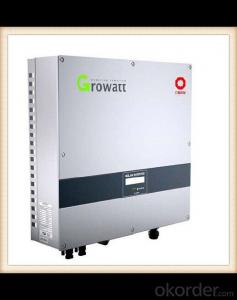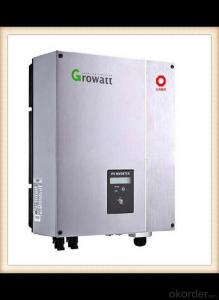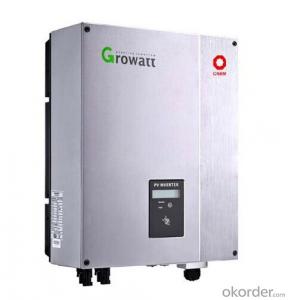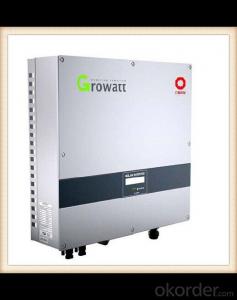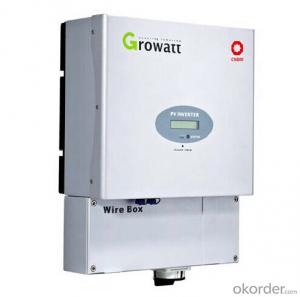Solar Inverter China CNBM-4000TL Grid-Tie Solar Inverter with Energy Storage Hybrid Solar Inverter
- Loading Port:
- China main port
- Payment Terms:
- TT OR LC
- Min Order Qty:
- 1000 watt
- Supply Capability:
- 100000 watt/month
OKorder Service Pledge
OKorder Financial Service
You Might Also Like
Introduction
CNBM-1000TL/1500TL/2000TL/3000TL/4000TL/4400TL/5000TL
Pure sine wave output
Microprocessor controlled to guarantee stable charging system
Multiple operations: Grid tie, Off grid, and grid tie with backup
Built-in MPPT solar charger
LCD display panel for comprehensive information
Multiple communication
Green substitution for generators
User adjustable charging current up to 25A
Maximum efficiency of 97.9% and wide
input voltage range
Wide MPPT voltage
Internal DC switch
Transformerless GT topology
Compact design
MTL – String
Multi-MPPT
Certificate: CE, VDE 0126-1-1,
DK5940, G83/1-1, G59/2, RD1663,
EN50438, VDE-AR-N4105, CEI-021,
IEC-62109, ENEL-Guide, UL1741,
UL1998, IEEE1547, CSA
Warranty: 5/10 years
Features
Maximum efficiency of 96.9% and wide input voltage range
Internal DC switch
MTL-String
Bluetooth/RF technology /wifi
Transformerless GT topology
5 years warranty(10years as optional)
Images
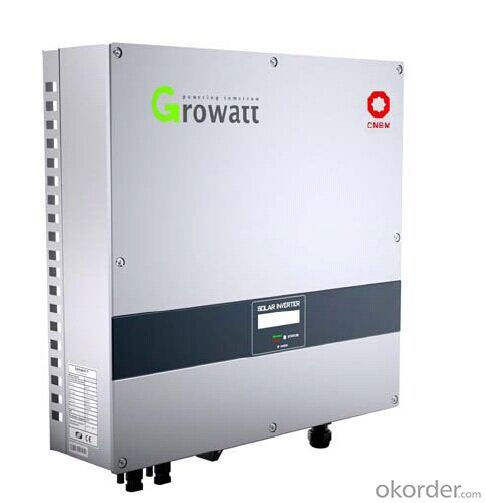
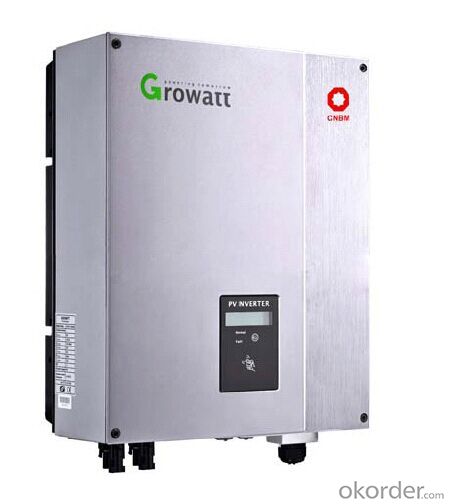

Sepecification

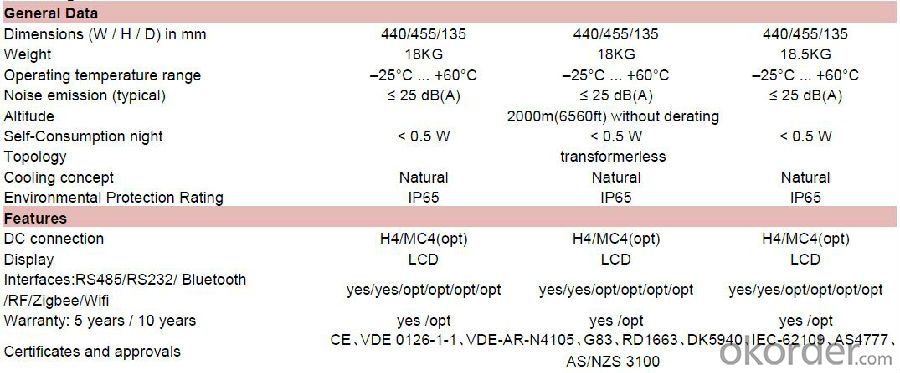
FAQ
Q1: How to choose a right inverter?
A1:Tell us your demand, then our sales will recommend a suitable inverter to you.
Q2: What's the different between inverter and solar inverter?
A2: Inverter is only accept AC input, but solar inverter not only accept AC input but also can connect with solar panel to accept PV input, it more save power.
Q3: How about the delivery time?
A3: 7 days for sample; 25 days for bulk order.
Q4: What is the warranty of inverter?
A4: 5/10 years warranty on CNBM-Solar product.
Q5: How to solve the technical problem?
A5: 24 hours after-service consultancy just for you and to make your problem to solve easily.
- Q: How does MPPT technology work in solar inverters?
- MPPT (Maximum Power Point Tracking) technology in solar inverters works by constantly monitoring the voltage and current of the solar panels and adjusting the resistance to ensure the panels are operating at their maximum power point. This optimization allows for maximum energy production from the solar panels, even in varying weather conditions and shading.
- Q: Can a solar inverter be used with a solar-powered swimming pool heater?
- Yes, a solar inverter can be used with a solar-powered swimming pool heater. The solar inverter is responsible for converting the DC (direct current) electricity produced by the solar panels into AC (alternating current) electricity that can be used to power the swimming pool heater.
- Q: What is the impact of a solar inverter on the overall system cost?
- The impact of a solar inverter on the overall system cost can be significant. A solar inverter is an essential component of a solar power system that converts the direct current (DC) generated by solar panels into alternating current (AC) that can be used to power electrical devices or be fed back into the grid. The cost of a solar inverter can vary depending on its capacity, efficiency, and brand. Generally, more advanced and efficient inverters tend to be more expensive. However, investing in a high-quality inverter can result in long-term savings and improved system performance. One important consideration is the size of the solar power system. Inverters have capacity limits, and selecting an appropriately sized inverter is crucial to optimize energy production and system efficiency. Choosing an undersized inverter can limit the system's performance, while an oversized inverter may result in unnecessary additional costs. The quality and reliability of the inverter are also important factors. A well-built and reliable inverter can minimize maintenance and repair costs, ensuring a longer lifespan for the solar power system. Additionally, advanced features like monitoring capabilities and grid integration functionalities can enhance the overall system performance and provide valuable data for maintenance and troubleshooting, but they may also increase the overall system cost. Moreover, the efficiency of a solar inverter can impact the overall system cost. Higher efficiency inverters can convert a greater amount of DC power into usable AC power, resulting in increased energy production and potentially reducing the number of solar panels required. This can lead to cost savings in terms of panel purchase and installation. In conclusion, while the cost of a solar inverter is an important consideration in overall system cost, it is crucial to balance it with factors such as capacity, efficiency, reliability, and additional features. Investing in a high-quality inverter that is appropriately sized can result in long-term savings, improved system performance, and higher energy production, ultimately maximizing the value and benefits of a solar power system.
- Q: How does a solar inverter handle voltage fluctuation during cloud cover?
- A solar inverter handles voltage fluctuation during cloud cover by continuously monitoring and adjusting the output voltage to compensate for the reduced solar energy input. This is typically achieved through advanced control algorithms that optimize the inverter's power output to maintain a stable voltage level, ensuring a smooth transition during periods of cloud cover and minimizing any disruptions to the electrical system.
- Q: How does a solar inverter handle low light conditions or cloudy days?
- A solar inverter handles low light conditions or cloudy days by adjusting its power output to match the available sunlight. It is designed to maximize the energy conversion efficiency even in low light situations, allowing for continuous power generation from the solar panels.
- Q: What is the role of a solar inverter in a solar-powered remote monitoring system?
- The role of a solar inverter in a solar-powered remote monitoring system is to convert the direct current (DC) electricity generated by the solar panels into alternating current (AC) electricity that can be used to power the monitoring system. It also ensures that the electricity generated matches the requirements of the monitoring equipment, regulates the voltage, and assists in efficient power transmission and distribution.
- Q: What are the key features to consider when choosing a solar inverter?
- When choosing a solar inverter, some key features to consider are the inverter's efficiency, maximum power point tracking (MPPT) capability, warranty and reliability, communication capabilities, and compatibility with your solar panels and battery system (if applicable).
- Q: How does a solar inverter affect the overall system efficiency at different temperatures?
- A solar inverter can affect the overall system efficiency at different temperatures by adjusting its operations to optimize performance. At higher temperatures, the efficiency of the inverter may decrease due to increased internal losses and reduced power output. To mitigate this, modern inverters utilize advanced technologies such as maximum power point tracking (MPPT) algorithms to adapt to the changing temperature conditions. These algorithms adjust the operating parameters of the inverter to maximize energy production by maintaining the optimal voltage and current levels. By dynamically responding to temperature changes, a solar inverter can help maintain higher overall system efficiency across a range of temperatures.
- Q: How is a solar inverter different from a regular inverter?
- A solar inverter is specifically designed to convert the DC (direct current) electricity generated by solar panels into AC (alternating current) electricity suitable for use in homes and businesses. On the other hand, a regular inverter is mainly used to convert DC electricity from batteries or other sources into AC electricity. Therefore, while both inverters convert electricity from one form to another, a solar inverter is tailored for the unique requirements of solar power systems.
- Q: What is the role of fault ride-through capability in a solar inverter?
- The role of fault ride-through capability in a solar inverter is to ensure the uninterrupted operation of the inverter during grid faults or disturbances. It allows the inverter to remain connected to the grid and continue generating power, even in the presence of temporary voltage dips or interruptions. This capability is essential for grid stability and reliability, as it helps prevent power outages and disruptions in the event of faults in the grid.
Send your message to us
Solar Inverter China CNBM-4000TL Grid-Tie Solar Inverter with Energy Storage Hybrid Solar Inverter
- Loading Port:
- China main port
- Payment Terms:
- TT OR LC
- Min Order Qty:
- 1000 watt
- Supply Capability:
- 100000 watt/month
OKorder Service Pledge
OKorder Financial Service
Similar products
Hot products
Hot Searches
Related keywords

